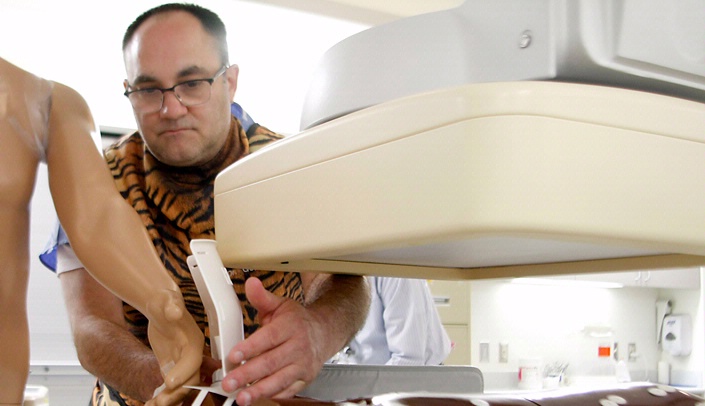A successful interventional radiology procedure can improve a patient’s life, but the people performing them, physicians like Greg Gordon, M.D., limp away feeling worse.
“I get home, and I can’t walk,” Dr. Gordon said. “I can’t move.”
Dr. Gordon invented two devices and built around them a new startup company, Radux Devices, which he hopes will make some of the pain and risk of IR a distant memory for him and other physicians. A recent proof-of-concept grant from the university’s Nebraska Research Initiative will give him the chance to prove his ideas can work.
Interventional radiologists like Dr. Gordon — who practices at Omaha’s VA Nebraska Western Iowa Health Care System while holding a faculty appointment at UNMC — use continuous X-ray scans to do things like injecting dyes and clearing arterial blockages through an access sheath, usually in a patient’s neck, arm or thigh.
In any IR procedure, Dr. Gordon must wear a lead-heavy protective apron that shields him from X-ray radiation. It’s not uncommon for physicians to wear the vest for up to 10 hours. Even with the 30-pound protective vest, radiation exposure is still a legitimate risk. The extra weight adds bodily stress and strain that, like radiation exposure, accumulates and gets worse over time.
Bodily stress, strain, and other similar injuries are common issues, and anywhere from 60 percent to 70 percent of interventional radiologists complain about spinal problems according to a 2009 study conducted by the Society of Interventional Radiology. Dr. Gordon said he’s had five knee surgeries and two hip procedures to fix the damage caused.
“I think my skillsets go down because I get pain and so stressed that I can’t maintain the steady hand that I need,” Dr. Gordon said.
Working so closely with X-ray radiation also increases the chances of developing health problems such as cataracts, breast cancer and central nervous system tumors. According to the same 2009 study, radiologists are three times more likely to die from brain cancer than physicians who do not use radiation.
Dr. Gordon’s solutions to the problems were a flexible sheath and a radiation shield. The sheath reduces radiation exposure by pushing physicians’ hands further away from the radiation field and allowing them to operate in more comfortable positions. The portable radiation shield, about the size of a steno notebook, blocks X-ray radiation from the physician’s hands and body.
